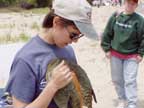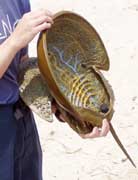|
|
 |
||||||
|
Volume 13, Issue 25 ~ June 23 -29 , 2005
|
|||||||
Lewis Museum is Maryland’s mecca for African American history By Carrie Steele Things don’t fall apart. Things hold. Lives connect in ways that last and last and lives become generations made out of pictures and words just kept. —Lucille Clifton: “Generations,” 1976 (inscribed on the museum’s wall) At zero years old, The Reginald F. Lewis Museum of Maryland African American History and Culture houses more than 400 years of history. It is, in Maryland poet Lucille Clifton’s metaphor, a place for holding the memories of generations. The museum stands in Baltimore’s much-visited Inner Harbor at Pratt Street and Presidents Avenue. The history it holds includes artifacts behind glass as well as photos and written memories of African American communities. “The relevance to Maryland is remarkable,” said Lt. Gov. Michael Steele at the preview June 21. “This is an institution that can grab kids and teach that poverty doesn’t have to bar success. The museum is a window for kids to see and share experiences of others and a mirror to see themselves,” said George Russell, chair of the museum’s board of directors. “This is a place where people will be transformed, because African American history is really American history.” Step Inside At first glance, the 82,000-square-foot, four-story building — all sharp angles and bright primary colors — jumps out of its urban surroundings. More contemplative is the atrium you enter off of Pratt Street, where you’re flanked by the gift shop, an information desk and grand staircase. The huge red wall representing freedom slices into the building from the sidewalk on Pratt Street. Climb the wide stairs and you discover that most of the museum presents itself in readings, photographs, objects, video interviews and short movies. There’s also a smattering of interactive activities; you can, for example, try out oyster-tongs to see just how hard they are to maneuver. You could breeze through the museum in about 35 minutes, said David Terry, director of exhibitions and collections. If you took time to read and listen to everything, you’d spend about two and a half hours. On the second floor, you’ll find an orientation foyer and the special exhibit, which will change every four to six months. Now on exhibit is the traveling A Slave Ship Speaks: The Wreck of the Henrietta Marie. Through the discovery of the Henrietta Marie, a slave ship which sunk off Key West in 1700, it tells the story of early slave trade from Africa. Along with story boards and colonial maps, you’ll see artifacts from the boat: nails, rigging, a cook stove, grisly pairs of shackles and the bell that bears the ship’s name. Walk through a small wooden passage, and low ceiling, dim light and planks show how Africans made the forced journey to America in the bottom of the boat. Climb next to the three permanent exhibits on the third floor. Building Maryland highlights African American labor throughout history, and especially three areas: water work, tobacco cultivation and iron forging. Things Hold, Lines Connect shows the social history through individuals stories and lives, photographs, a recreated barbershop wall and even a mini-chapel where up front is a flat-screen video of church oral histories. Finally, Strength of Mind captures the creative spirit of African Americans, and you’ll see the stories of Billie Holiday, Cab Calloway and Eubie Blake, as well as notables such as Benjamin Banneker and famous African American artists. The top fourth floor seems all business, with administrative offices and a distance-learning classroom, where speakers can address audiences present and far away. Until you discover the oral history recording studio, where you can hear complete recordings of Maryland African Americans (voices that you may have sampled as snippets downstairs). Or record your own, or grandma’s, oral histories. The museum has already collected about 180 such recordings. Teaching Us All “Important historic objects and stories were at danger of being lost forever,” said Steele, who praised the Lewis Museum as a monument validating the black experience in American culture. When we were kids, he said, we had a “wow” reaction visiting places like Busch Gardens. “This museum is going to be a huge ‘wow’ moment for us,” he said. “Every school kid will know this place and be a part of this place. This museum truly proves that we are more than the color of our skin.” The museum’s namesake, Baltimorean Reginald Lewis, was a lawyer and entrepreneur who was chief executive officer of Fortune 500 food giant TLC Beatrice International. He died at the age of 50 in 1993. “Reginald said, ‘I want my legacy to be education,’” said Nancy Grasmick, state superintendent of the state Department of Education. To make the link, the state school department has created a series of African American lessons for every elementary and middle school classroom to reach out to the 900,000 children in Maryland public schools. Three hundred thousand kids and adults are expected to visit the Reginald F. Lewis Museum of Maryland African American History and Culture in its first year, hearing personal accounts of the black experience from laborers, teachers, activists, artists, explorers, politicians, preachers, writers and more. “This is so much a personal story, like no other in the nation,” said Sandy Bellamy, executive director of the museum, who’s from St. Michaels. “Some of these artifacts have never been displayed anywhere else in the world.” Grand Opening weekend: Sat., June 25, ribbon cutting ceremony, with speakers including Mrs. Reginald Lewis, Mayor Martin O’Malley and Lt. Gov. Michael Steele. Next come dancers, musicians and storytellers: Sun., June 26, African dancing, choirs, storyteller JaHipster and more. 10am-5pm at Reginald F. Lewis Museum, 830 East Pratt St., Baltimore. Ceremony free; museum entrance $5: www.AfricanAmericanCulture.org.
Brandon Clough was decked out in a Motocross T-shirt, looking like any other kid at the beach, until his fellow fourth graders at Sudlersville Elementary School in Queen Anne’s County pinned straws, balloons and feathers all over him. Not to worry. It’s all part of the program at Calvert County’s Flag Ponds Nature Center for Horseshoe Crab Field Day. Brandon and his classmates were among 120 elementary and middle schoolers, from four Maryland schools, who had come to learn about the anatomy, management and mating habits of these ancient arthropods. They also learned how the lives of horseshoe crabs intersect with those of shorebirds that migrate from South America to the Arctic each spring, stopping at sandy beaches to bulk up on horseshoe crab eggs. The Sudlersville Elementary students were applying an interactive lesson in the physical adaptations of shorebirds to their environment by transforming Brandon into a shorebird of sorts. The attachments represented such avian adaptations as air sacs, long legs and down feathers. “Brandon bird is very vulnerable on this beach to predators,” Elena Takaki of the Maryland Department of National Resources told her charges. “What can he do to help from being eaten?” “Camouflage,” a boy volunteered. And he draped a camo-colored cloth around Brandon’s shoulders.
The events culminate a year of horseshoe crab studies, with students raising the ancient mariners, feeding them, measuring their growth and testing water quality. Maryland’s Raising Horseshoe Crabs in the Classroom program gives students hands-on experience in Chesapeake Bay horseshoe crab management. The previous week at Flag Ponds, high school students had their own day to learn about horseshoe crabs. “The high schoolers acted almost as teachers for us, and it was fantastic,” said Lucy Tonacci, a volunteer with the Calvert County Natural Resources Division. Back at the event for middle and elementary kids, students representing ruddy turnstones, red knots and sanderlings, a trio of shorebirds, rushed down to the high tide line to pick up horseshoe eggs, here represented by black beans. Classmates impersonating stressors such as late spring storms, feral cats and a low number of horseshoe crab eggs tried to tag the shorebirds before they reached their destination. Students also simulated a horseshoe crab population survey. White and amber Frisbees took the place of live male and female crabs. One was awed that a female horseshoe crab can lay up to 80,000 eggs in a season. “Why so many?” asked Takaki. “Because birds eat them,” another girl offered “That’s right,” Takaki said. “They know that the shorebirds are going to eat them, so they lay extra.” Meanwhile Sheila Eyler, a biologist with the U.S. Fish and Wildlife Service in Annapolis, showed students from Baltimore’s Emmanuel Lutheran School a small bottle of blue liquid. She explained that the substance was horseshoe crab blood and that a compound in the blood is used to test medical instruments for sterility. She also fielded questions about the horseshoe crabs: “Do they fight?” “Can the man fertilize more than one female?” And, most important, “What’s in that box?” She reached into a container and brought out a punch bowl-sized shell of a female crab, perhaps 18 inches long. “Whoa!” said a boy, startled. “This is a female,” Eyler said. “We know it’s a female [because of the large size], and this one is about as big as it gets.” —Edward Engel |
|||||||
|
|
|||||||
|
© COPYRIGHT 2004 by New Bay Enterprises, Inc. All rights reserved.
|



